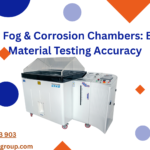In today’s competitive manufacturing environment, corrosion resistance is one of the most critical factors determining the quality and durability of products. From automotive components to coatings and paints, manufacturers need to ensure their products withstand harsh environments before reaching customers. One of the most reliable methods for evaluating corrosion resistance is the Salt Spray Test, conducted using a Salt Spray Chamber.
This blog will walk you through the basics of salt spray testing, different types of chambers like CASS cum Salt Spray Chamber and Cyclic Salt Spray Chamber, and why this testing is essential for industries.
What is a Salt Spray Chamber?
A Salt Spray Chamber is a laboratory testing instrument designed to simulate a highly corrosive environment. It exposes coated, painted, plated, or metal specimens to a continuous salt fog (sodium chloride mist) to evaluate their ability to resist corrosion.
By replicating real-world conditions in a controlled environment, manufacturers can predict how a product will perform over time and make improvements to enhance its durability.
What is the Salt Spray Test?
The Salt Spray Test is one of the oldest and most widely used methods to assess corrosion resistance.
-
Principle: Test specimens are placed inside a sealed chamber where a salt solution (usually NaCl) is atomized into a fine mist.
-
Conditions: The chamber maintains specific temperature and humidity levels to accelerate corrosion.
-
Observation: The time taken for rust, blistering, or coating breakdown is recorded.
This test is particularly useful for evaluating:
-
Painted and coated surfaces
-
Zinc, nickel, or chrome-plated components
-
Automotive and aerospace parts
-
Hardware, fasteners, and construction materials
Types of Salt Spray Chambers
1. Standard Salt Spray Chamber
The basic version creates a continuous salt fog environment to test coatings and metal surfaces. It is widely used across industries like automotive, electronics, and construction.
2. CASS cum Salt Spray Chamber
CASS (Copper Accelerated Acetic Acid Salt Spray) Test is a more advanced form of salt spray testing. In a CASS cum Salt Spray Chamber:
-
A mixture of copper chloride and acetic acid is added to the salt solution.
-
The test is more aggressive and designed to evaluate decorative coatings like nickel-chrome plating.
-
It is particularly suitable for industries where higher corrosion resistance is required (e.g., automotive trims, bathroom fittings, and luxury hardware).
3. Cyclic Salt Spray Chamber
Unlike the continuous fog test, a Cyclic Salt Spray Chamber simulates real-world conditions by combining different environmental cycles such as:
-
Salt fog exposure
-
Drying cycles
-
Humidity cycles
-
Air drying or condensation
This makes it more realistic for evaluating corrosion resistance over long-term exposure to changing weather conditions. Automotive and aerospace industries often prefer cyclic tests to replicate outdoor performance.
Why is Salt Spray Testing Important?
-
Quality Assurance – Ensures coatings and finishes meet required durability standards.
-
Product Reliability – Detects weaknesses before products enter the market.
-
Standard Compliance – Meets global testing standards like ASTM B117, ISO 9227, and JIS Z 2371.
-
Customer Satisfaction – Reduces complaints, product returns, and warranty claims.
-
Competitive Advantage – Stronger, corrosion-resistant products stand out in the market.
Salt Spray Test Standards
Some commonly followed international standards include:
-
ASTM B117 – Standard Practice for Operating Salt Spray Apparatus.
-
ISO 9227 – Corrosion Tests in Artificial Atmospheres: Salt Spray Tests.
-
JIS Z 2371 – Japanese Industrial Standard for Salt Spray Testing.
Following these standards ensures test results are globally accepted and comparable across industries.
Applications of Salt Spray Chambers
Salt Spray Chambers are widely used in industries such as:
-
Automotive: Testing car body panels, fasteners, and trims.
-
Aerospace: Ensuring parts can withstand atmospheric exposure.
-
Paints & Coatings: Checking protective performance of powder coatings, paints, and varnishes.
-
Electronics: Verifying corrosion resistance of connectors and metal casings.
-
Construction: Assessing performance of steel, hardware, and building materials.
Factors to Consider Before Choosing a Salt Spray Chamber
When selecting a Salt Spray Chamber, keep these points in mind:
-
Type of Test Required: Standard, CASS, or Cyclic.
-
Chamber Size: Depending on sample dimensions and testing volume.
-
Temperature & Humidity Control: Accuracy of environmental parameters.
-
Compliance with Standards: Ensure chamber meets ASTM, ISO, or JIS standards.
-
Durability & Maintenance: Look for high-quality construction for long-term use.
A Salt Spray Chamber is an indispensable tool for industries aiming to deliver durable, corrosion-resistant products. Whether you need a standard salt spray test, a CASS cum Salt Spray Chamber for advanced coatings, or a Cyclic Salt Spray Chamber to replicate real-world weather conditions, investing in the right testing equipment ensures quality, reliability, and compliance with international standards.
By simulating harsh environments in the laboratory, manufacturers can predict product performance, reduce failures, and maintain a strong reputation in the market.
📞 Looking for the best Salt Spray Chamber for your industry?
Contact Presto Group, one of the leading manufacturers of advanced testing instruments in India.
👉 Call us today at +91 9210 903 903
📧 Email: info@prestogroup.com
Ensure your products withstand the test of time with Presto’s reliable corrosion testing solutions!

